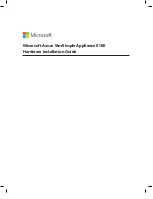
AirLive IP-2000VPN User’s Manual
170
Policies
VPN configuration settings are stored in
Policies
.
Note that different vendors use different terms. Generally, the terms "VPN Policy", "IPSec Policy", and "IPSec
Proposal" have the same meaning. However, some vendors separate IKE Policies (Phase 1 parameters) from
IPSec Policies (Phase 2 parameters).
For the IP-2000VPN, each VPN policy contains both Phase 1 and Phase 2 parameters (if IKE is used). Each
policy defines:
•
The address of the remote VPN endpoint.
•
The traffic which is allowed to use the VPN connection.
•
The parameters (settings) for the IPSec SA (Security Association).
•
If IKE is used, the parameters (settings) for the IKE SA (Security Association).
Generally, you will need at least one (1) VPN Policy for each remote site for which you wish to establish VPN
connections.
It is possible, and sometimes necessary, to have multiple Policies for the same remote site. However, you
should only Enable one (1) policy at a time. If multiple policies for the same remote site are enabled, the
policies are examined in the order in which they are listed, and the first matching policy will be used. While it is
possible to change the order of the policies, it may not be easy to get the desired action from multiple policies.
VPN Configuration
The general rule is that each endpoint must have matching Policies, as follows:
VPN Endpoint
address
Each VPN endpoint must be configured to initiate or accept connections to the
remote VPN client or Gateway.
Usually, this requires having a fixed Internet IP address or domain name. However,
it is possible for a VPN Gateway to accept incoming connections from a remote
client where the client's IP address is not known in advance.
Traffic Selector
This determines which outgoing traffic will cause a VPN connection to be
established, and which incoming traffic will be accepted. Each endpoint must be
configured to pass and accept the desired traffic from the remote endpoint.
If connecting 2 LANs, this requires that:
•
Each endpoint must be aware of the IP addresses used on the other endpoint.
•
The 2 LANs MUST use different IP address ranges.
IKE parameters
If using IKE (recommended), the IKE parameters must match (except for the SA
lifetime, which can be different).





































